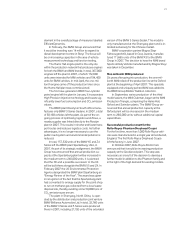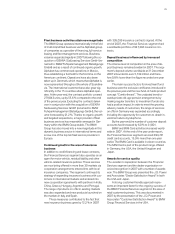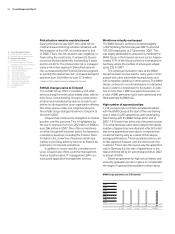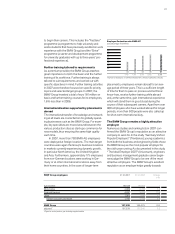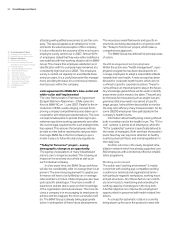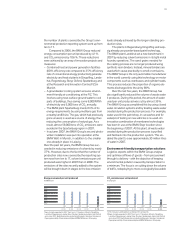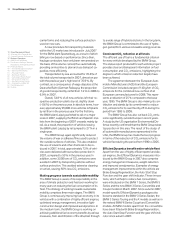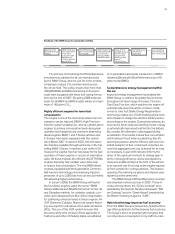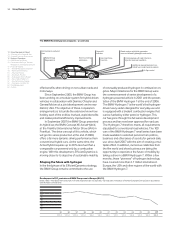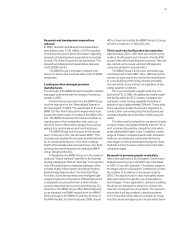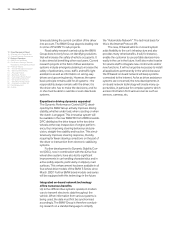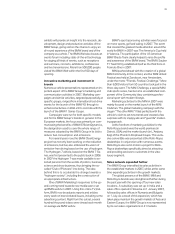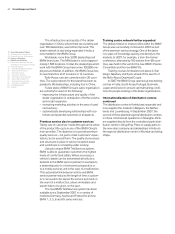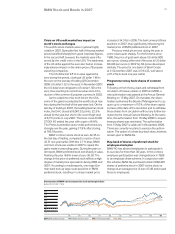BMW 2007 Annual Report Download - page 33
Download and view the complete annual report
Please find page 33 of the 2007 BMW annual report below. You can navigate through the pages in the report by either clicking on the pages listed below, or by using the keyword search tool below to find specific information within the annual report.
31
the number of plants covered by the Group’s envi-
ronmental protection reporting system went up from
ten to 17.
Compared to 2006, the BMW Group reduced
energy consumption per unit produced by 4.1 %
and CO2 emissions by 10.6 %. These reductions
were achieved by an array of innovative projects and
measures:
–
Combined heat and power generation facilities
(80 % efficiency rate compared to 35 % efficiency
rate of conventional energy production) generate
electricity and heat at plants in Dingolfing, Lands-
hut, Regensburg, Steyr, Oxford, Spartanburg and
at the Research and Innovation Centre (FIZ) in
Munich.
– A groundwater cooling system ensures environ-
ment-friendly air conditioning at the FIZ. This
involves using near-surface ground water to cool
parts of buildings, thus saving some 8,000 MWh
of electricity and 5,000 tons of CO2 annually.
– The BMW plant Spartanburg meets 63 % of its
energy requirements by using methane gas from
a nearby landfill site. The gas, which had previously
gone unused, is used as a source of energy, thus
reducing the consumption of natural gas. As a
result, almost 59,000 tons of CO2 emissions were
avoided in the Spartanburg region in 2007.
– In autumn 2007, the BMW Group’s second photo-
voltaic installation was put into operation at the
BMW Welt in Munich, in addition to the smaller
one already in place in Leipzig.
Over the past ten years, the BMW Group has suc-
ceeded in reducing emissions of solvents by nearly
37 %. However, due to the fact that the num ber of
production sites now covered by the reporting sys-
tem rose from ten to 17, solvent emissions per unit
produced were higher in 2007 than in 2006. The
emissions of the sites recently added to the system
will be brought down in stages to the low emission
levels already achieved by the longer-standing pro-
duction sites.
The plants in Regensburg, Dingolfing and Leip-
zig already use powder-based paint technology.
The BMW plant Landshut set a new benchmark in
2007 by reducing solvent emissions in its light metal
foundry operations. The sand grains needed for
the casting process are no longer produced using
synthetic resin binders. Instead, mineral binders are
used which cause practically no smell or emissions.
The BMW Group is the only automobile manufacturer
in the world currently using this technology on motor
components such as crankcases and cylinder heads.
This process reduces the proportion of organic ele-
ments discharged into the air by 98 %.
Over the last five years, the BMW Group has
also significantly reduced the volume of waste water
it produces. During this period, the amount of water
used per unit produced was cut by almost 35 %.
The BMW Group accomplished this by using closed
water circulation systems and by treating waste water
created during the production process. For example,
water used in the paint shop, in car washes and for
waterproof testing on new vehicles is re-used. An
innovative combination of membrane technologies
has been in use at the BMW Steyr location since
the beginning of 2007. At this plant, all waste water
created during the production process is purified
and fed back into the production system. This en-
abled the plant to save approximately 30 million litres
of water in 2007.
Environment-friendly transportation solutions
Logistics experts within the BMW Group analyse
and optimise all flows of goods – from procurement
through to delivery – with the objective of keeping
environmental pollution caused by transportation to
a minimum. The focus is on cutting down the volume
of traffic, redeploying to more ecologically favourable
Energy consumed per unit produced
in MWh/unit
3.10
3.00
2.90
2.80
2.70
2.60
03
2.94
04
2.94
05
2.94
06
2.90
07
2.78
* Basis for data expanded in 2007 from ten to 17 locations: Munich, Dingolfing,
Landshut, Regensburg, Leipzig, Steyr, Rosslyn, Spartanburg, Hams Hall, Oxford
and, since 2007, Berlin (brake disc production), Eisenach, Swindon, Goodwood,
Rayong (assembly), Chennai (assembly) and BMW Brilliance in Shenyang.
*
CO2 emissions per unit produced
in tons/unit
1.05
1.00
0.95
0.90
0.85
0.80
03
1.00
04
0.94
05
0.99
06
0.94
07
0.84
1] The increase is attributable to a change in the energy mix.
2] Basis for data expanded in 2007 from ten to 17 locations: Munich, Dingolfing,
Landshut, Regensburg, Leipzig, Steyr, Rosslyn, Spartanburg, Hams Hall, Oxford
and, since 2007, Berlin (brake disc production), Eisenach, Swindon, Goodwood,
Rayong (assembly), Chennai (assembly) and BMW Brilliance in Shenyang.
2]
1]


